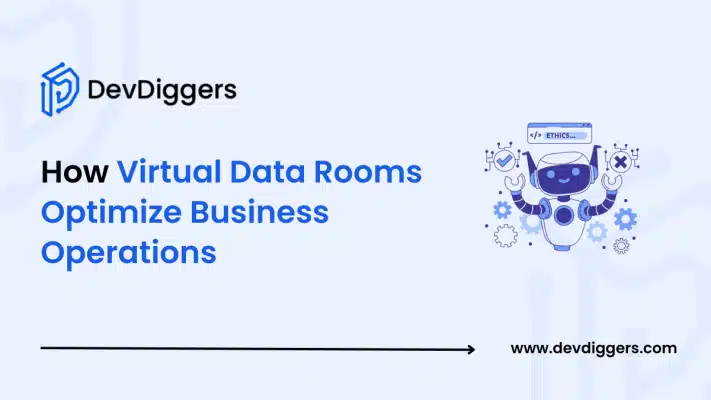Ways A Virtual Data Room Can Streamline Your Business Operations

In today’s world of business, efficiency, security, and adaptability are very important. In modern times, companies deal with large amounts of information that must be properly controlled, stored and shared through powerful tools in a secure manner. However, virtual data rooms are the game changer for this.
From basic digital warehouses to a complete operation platform, which enhances productivity by securing vital data, facilitating better decision-making processes, and optimizing workflow.
Consequently, VDRs offer more than just great documentation options; businesses that wish to stay competitive amid rapid digitalization can also find advanced cyber-security features there.
This blog will discuss some of the benefits of using virtual data rooms, including efficiency and protection; it will look at how they impact brand reputation and integrate into daily operations within the company.
We would provide you with practical guidance on selecting the right VDR provider, tips for seamless adoption, or suggestions on what’s new in VDR technology today.
If you are new in the field of virtual data rooms or if you need to improve your existing system, this guide will provide you with all the necessary information on how to make good use of your VDRs.
Let us first discuss how transformative virtual data rooms can be for any business!
How Virtual Data Rooms Enhance Business Efficiency and Security

1. Efficient Record Keeping
Data rooms have revolutionized the process of record keeping. Gone are the days when you would have to navigate piles of scattered files to retrieve important documents. With a data room, you can save all your paperwork at a secure, centered location. You can not only save time but reduce the risk of losing critical information.
Most data rooms offer built-in file-organizing templates. You can drag and drop your files and ensure everything stays in chronological order. With every folder marked and tagged, you can retrieve information in seconds.
Many data rooms also provide watermarking features to deter the unauthorized distribution of documents. A virtual data room keeps a record of who has viewed, edited, or shared a file. This total transparency can streamline your business operations.
2. Built-in Backup Solutions
Data rooms offer a robust data backup system to ensure the security of stored data. They store data on redundant servers across multiple locations. If a single server fails, your data will remain secure. Moreover, cloud-based services are used to back up data offsite automatically.
Many data rooms offer version control features. For example, you can view past versions of a document and restore them in case of accidental deletion or a security breach. In case of a ransomware attack, you can access information from the backup servers.
Virtual data rooms have a quick and efficient disaster recovery mode. This minimizes downtime in case of a major system failure.
3. Cybersecurity Coverage
Businesses all over the world are facing cybersecurity threats. Here’s how a business can lose important data:
- Email Phishing: It occurs when an email is sent from a legitimate-looking organization, such as a company or a bank. The sender uses logos and branding to make the source appear authentic. The recipient is asked to share personal details, such as a security code or password. The sender also creates a sense of urgency to avoid giving the recipient a chance to verify the source. If an employee clicks on the link shared or inserts their personal information, hackers can access your business’s sensitive client or financial information.
- Ransomware: If an attacker infiltrates your system, they can deploy malicious software to access your files and demand payment in exchange. Hackers can lock your access and disrupt business operations.
- Hardware Loss or Theft: Despite having cloud storage services, many businesses store sensitive data on their company laptops or phones. A stolen or lost device is almost impossible to recover. A hacker would quickly overwrite the password and gain unlimited access.
- Insider Threat: An insider threat in cybersecurity refers to a threat posed by someone within the organization. This could be an employee, an investor, or a contractor. They can harm the organization intentionally or unintentionally by stealing information and causing system damage. Former employees can also leak sensitive information to competitors.
Despite stringent firewalls and strong anti-virus software, sensitive information can fall into the wrong hands. This is where data rooms come in. Encryption technology makes data untraceable to unauthorized individuals.
Moreover, virtual data rooms feature multi-factor authentication. Users can only access data after clearing multiple forms of identification.
4. Brand Image Enhancement
Streamlined business operations and robust security measures are two critical components needed to boost a company’s reputation.
Data rooms ensure that all business documents and client information are securely stored. If you’re running a private equity firm, you need an efficient system for initial public offerings (IPOs), due diligence, and fundraising.
A virtual data room allows you to retrieve information quickly and present it to investors in an orderly fashion.
This will set you apart from competitors and boost your image as a technologically driven corporation. Present yourself as an innovative and forward-thinking company and earn consumers’ trust.
5. Data-Driven Decision Making
Whether you’re running a commerce powerhouse or an investment firm, staying ahead of the competition requires innovation and constant improvement.
Data-driven decision-making is one way to stand out in the market, and data rooms facilitate it. The ability to identify market trends and make continuous improvements can help you make informed decisions.
Data rooms have advanced search capabilities. Users can quickly sift through vast databases and perform targeted analysis. Teams can conduct research and share it on one platform.
Through data visualization tools, such as charts, graphs, and tables, they can easily decode complex information and understand patterns.
You can share these actionable insights with employees and determine the best course of action. With data rooms, your valuable insights will remain secure and be readily available for future use.
6. Automated Workflows
For years, businesses have relied on manual task assignments and workflow procedures. However, constant communication and follow-ups have become exhausting.
Manual task assigning can lead to mistakes and delays, as well as task overlapping, which can lead to unnecessary stress and lower productivity.
In comparison, data rooms allow you to automate task assigning, follow-up checks, and progress tracking. Teams can interact on a single platform and resolve issues timely. Replace outdated manual processes and create a more productive work environment.
7. Streamlined Communication
Whether you’re conducting due diligence or negotiating during a mergers and acquisitions deal, back-and-forth communication can be exhausting.
If you’re exchanging physical documents, there is a high risk of data loss. Meanwhile, sending files via email can lead to data breaches. Physical distance or time zone differences can further cause delays.
A virtual data room will improve the efficiency of the deal-making process. You can set up alerts for investors and stakeholders to accelerate the process.
Virtual data rooms eliminate the need for various email threads and physical meetings. All parties can have access to the current version of a document, regardless of location.
How To Choose A Virtual Data Room Provider

Choosing a virtual data room provider that caters to your business requirements without breaking the bank is no easy feat. Here’s how you can streamline the process:
1. Assess Your Needs
Every business is unique, and so are its data management needs. Clearly define your goals and objectives.
Some companies wish to add a layer of security, while others want to streamline communication with other investors.
By having a clear rundown of your specific operational goals, you can quickly choose a VDR provider.
2. Explore Various Features
Not all data rooms are created equal. The features vary depending on the nature of your business and your budget. If you are acquiring data room services for a pharmaceutical firm, you will need watermarking and multi-factor authentication to protect sensitive patient data or patents.
Whereas, for law firms, document management features will be of greater benefit. Find a data room vendor that offers a wide range of already existing and customized features to streamline your business operations.
3. Set a budget
It is quite easy to go overboard when you’re shopping for digital tools for your business. Therefore, it is important to budget beforehand.
Determine how much you can realistically spend on the virtual data room. Have a rough estimate in mind before exploring the market.
4. Get Quotes
Variety is key when it comes to buying a VDR. Reach out to various data room vendors and share your requirements and desired features. Get quotes and compare them, factoring in the provided features. Many vendors give you the opportunity to test the data room.
You can test the product’s security features and user-accessibility. This will help you make an informed purchase.
5. Review Customer Service
There is nothing worse than your system breaking down in the middle of an important meeting. So, choose a data room provider that offers 24/7 customer support.
Efficient customer service can make all the difference. They will quickly review the issue and deploy a technical support team. This will give you peace of mind, knowing you have a robust backup system in case of emergencies.
6. Assess Usability
If the virtual data room is complex to navigate, there is no point in investing. Test the usability of VDRs offered by different vendors and choose the most beginner-friendly option.
For streamlined operations, train your employees regardless of their technical background.
7. Compliance With Regulations
Make sure the data room provider complies with relevant security regulations. Advanced certifications such as SOC 2, ISO 27001, and SSAE 16 can determine the quality of features offered by the provider.
Compliance with laws such as the General Data Protection Regulation (GDPR) is a plus point for the data room provider.
Integrating Virtual Data Rooms into Business Operations

1. Onboarding Your Team to Use Virtual Data Rooms Effectively
The successful adoption of VDRs begins with effective onboarding. Providing comprehensive training to employees ensures they understand how to navigate the platform and utilize its features.
Tutorials, workshops, and user manuals can significantly enhance adoption rates and streamline the transition from traditional methods to digital solutions.
2. Customizing Virtual Data Rooms to Fit Your Business Needs
Every business has unique operational requirements, and virtual data rooms can be tailored to meet these needs. From setting up industry-specific templates to enabling custom workflows, businesses can configure their VDRs for maximum efficiency.
For instance, financial firms can prioritize data encryption and compliance tools, while creative agencies may focus on collaboration and file-sharing features. Customization ensures that the VDR seamlessly integrates into existing processes, enhancing productivity without disrupting workflows.
3. Best Practices for Maximizing VDR Efficiency in Day-to-Day Tasks
To fully leverage a virtual data room, businesses should establish best practices, such as consistent folder organization and version control.
Assigning user roles and permissions can prevent unauthorized access while enhancing collaboration. Regular audits of stored data can also help maintain an efficient and clutter-free workspace.
4. Building a Seamless Workflow Around Virtual Data Rooms
Integrating VDRs with other business tools like project management software can further streamline workflows.
Automation features like task assignments and deadline reminders can reduce administrative burdens and ensure smooth operations.
Innovations in Virtual Data Room Technology

- AI Features Transforming Virtual Data Rooms: Artificial Intelligence is revolutionizing virtual data rooms by introducing features like automated document indexing, keyword recognition, and predictive analytics. These advancements not only save time but also provide valuable insights that can drive strategic decisions.
- Mobile Compatibility: Managing Your VDR On the Go With the rise of remote work, mobile-compatible VDRs have become essential. Business leaders can now access critical files, approve documents, and collaborate with teams from anywhere in the world, ensuring uninterrupted operations.
- Future Trends: What’s Next for Virtual Data Rooms? The future of VDR technology points toward enhanced collaboration tools, integration with blockchain for added security, and AI-driven insights. As businesses continue to digitalize, virtual data rooms will remain a vital tool for operational efficiency.
Challenges and Solutions When Adopting Virtual Data Rooms

- Overcoming Initial Implementation Barriers: Transitioning to a VDR can seem daunting, especially for businesses accustomed to traditional methods. To ease the process, organizations should choose user-friendly platforms and provide adequate training. Gradual implementation, starting with less critical processes, can also help teams adapt more comfortably.
- Addressing Security Concerns( Myths vs. Realities): While some businesses hesitate to adopt VDRs due to security concerns, these platforms are often more secure than traditional methods. Encryption, multi-factor authentication, and regular security audits make VDRs a robust solution for protecting sensitive data.
- Budget Constraints? Affordable VDR Solutions for Small Businesses: For small businesses with limited budgets, several cost-effective VDR providers offer scalable solutions. These platforms provide essential features without the hefty price tag, ensuring that even smaller companies can benefit from streamlined operations.
Final Thoughts
Virtual data rooms are becoming popular among businesses as they help streamline operations and fast-track processes. With VDRs, you can efficiently manage data storage, sharing, and access.
You can make data-driven business decisions and build your image as technologically innovative.
Virtual data rooms can also strengthen your security measures and prevent cyberattacks. From law firms to private equity firms, data rooms ensure success for all.

Abhijit Sarkar
I am deeply passionate about creating engaging content and exploring. My journey includes gaining valuable experience in content writing and creating useful resources for my readers.

Leave a Reply